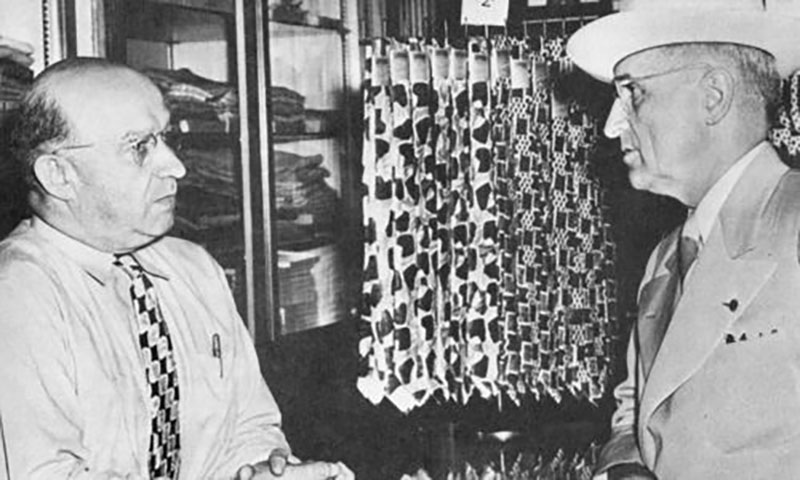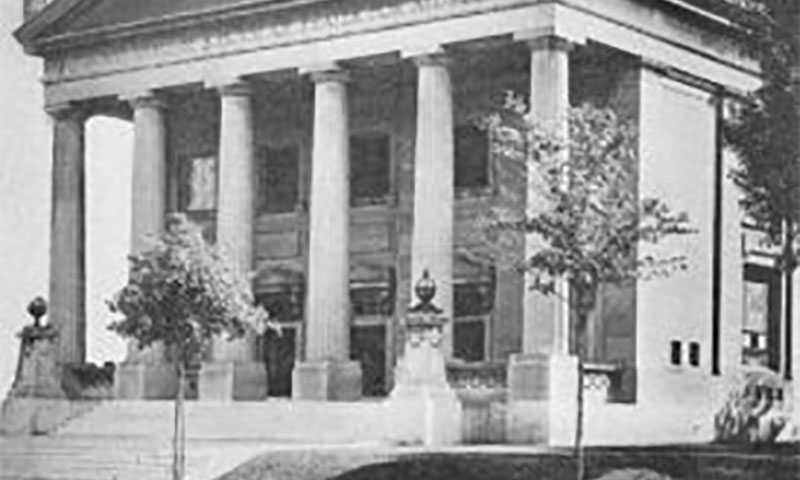Stories to Share

A Moment in Our History
Click here to read A Moment in Our History, by B’nai Jehudah member Dan Stolper.

Roots in a Moving Stream
Our historical accounts would not be possible without the work of Frank Adler, z”l, author of Roots in a Moving Stream. Special thanks to Dan Adler for creating and sharing this digital copy. You can find it here.
Beginnings
Jewish settlers lived in and around the Kansas City area since the 1840s. Congregation B’nai Jeshurun in Leavenworth and Congregation Adath Joseph in St. Joseph were both founded before the Civil War and Jewish cemeteries were established in Eudora, Leavenworth and St. Joseph during these years. Manheim Goldman was a Jewish merchant in Liberty and served as that city’s mayor twice.
The Hebrew Benevolent Society of Kansas City was formed in 1865 to facilitate burials and shivas. It paid $500 for ground at 18th and Lydia for the city’s first Jewish cemetery. The first burial was that of 22-year-old Helena Baum in 1866.
The town of Kansas (City) grew quickly after the completion of the Hannibal Bridge in 1869. It was the first permanent rail crossing of the Missouri River. The Jewish community here received its share of new arrivals and talk of forming a congregation had circulated for a few years.
The idea of starting a congregation was renewed at Rosh Hashanah services in 1870. The following Sunday, October 2, a meeting was held in a room above a grocery store near the riverfront. Twenty-five men pledged $800 to begin Kanas City’s first Jewish congregation. They were merchants, tobacconists, saloon owners and butchers, among other occupations. Most had roots in Germany or the countries under Germany’s influence.
By December 2, 1870, the fledgling B’nai Jehudah (children of Judah) congregation had rented temporary space at the Northwest corner of 8th and Main Streets. The congregation was Reform from the beginning. Mixed family pews and a choir composed of men and women were in contrast to traditional synagogues where seating was segregated by gender.
The new congregation engaged Marcus R. Cohen, a mohel from Chicago as its first Rabbi and services were read from Minhag America, the first siddur published in the United States. Its author was Rabbi Isaac Mayer Wise, an early pioneer of Reform Judaism in America.
One of our current members descend from B’nai Jehudah’s 25 founding members. Mary Davidson z”l is the granddaughter of Bernhardt Davidson, an immigrant who fought with the Confederate Army and was a cigar maker and undertaker. He served as B’nai Jehudah’s treasurer and cemetery warden. Nancy Reicher is the great-granddaughter of Bernhard Ganz who was a clothier and insurance agent and fought with the Union Army. Mr. Ganz was a B’nai Jehudah treasurer and vice president during the first decade of the congregation’s existence.
(Adapted from Roots In A Moving Stream by Frank Adler z”l)
B’nai Jehudah and Mrs. O’Leary’s Cow
Many of us learned the children’s song A Hot Time in the Old Town Tonight which tells the legendary story of the origin of the great Chicago fire of 1871. In late 1870, just weeks after the congregation’s founding, the ladies of B’nai Jehudah formed an auxiliary called the Hebrew Ladies’ Relief Society. It was likely the precursor of our Sisterhood organization. These charitable ladies supported the congregation and the less fortunate in our community. They began a systematic program of almsgiving that continued for many years.
The Hebrew Ladies’ Relief Society planned the congregation’s first fund-raiser for early fall 1871. The original plan was to use the proceeds of the ball to begin a building fund for the congregation. The ball netted $275, equivalent to over $5,000 in today’s dollars as adjusted for inflation.
On October 8, 1871, a three-day-fire began which consumed much of the city of Chicago. While never proven, legend held that the fire started when Mrs. O’Leary’s cow knocked over a lantern in a barn. The fire destroyed 17,500 mostly wooden buildings, killed hundreds and left one of every three residents homeless.
The B’nai Jehudah ladies met and decided to donate the entire proceeds of their ball to relief for the people of Chicago. Not knowing any other way of sending it, the funds were entrusted to the Mayor of Kansas City to transmit to Chicago. The building fund would have to wait.
This endeavor is one of the first examples of the congregation’s commitment to social justice and the needs of others, a core value that continues today.
The Chicago City Council exonerated the O’Leary family and its cow in 1997, believing that the family had been falsely accused. Justice was finally done, albeit more than 100 years late.
(Adapted from Roots In A Moving Stream by Frank Adler z”l)
Our First Cemeteries
Typically, one of the first priorities for a Jewish community is establishing a cemetery. Kansas City was no different. The Kansas City Hebrew Benevolent Society paid $500 for ground at 18th and Lydia on May 14, 1866 for the city’s first Jewish cemetery. The Society’s leaders were among the same group that formed Congregation B’nai Jehudah on October 2, 1870. The first burial was in September 1866, after 22-year-old Helena Baum of Pleasant Hill was killed in a railroad accident.
Soon after the Congregation’s founding, the Benevolent Society dissolved and ceded the cemetery to B’nai Jehudah. The congregational leaders realized that the cemetery soon would be inadequate in size and already was being crowded by the city’s rapid growth. A move was necessary.
In November 1872, B’nai Jehudah bought a two-acre tract in Elmwood Cemetery, two miles east of the city. The price of $2,000 was satisfied by a cash payment of $200 and the trade-in of the original cemetery property.
The 37 remains interned at 18th and Lydia were exhumed by the labor of men with shovels. These caskets and headstones were loaded onto horse-drawn wagons and transferred to Elmwood, 2.7 miles to the east at 4900 E. Truman Road, then known as 15th Street.
The new congregational cemetery was consecrated Sunday, November 24, 1872. During the next ten years, B’nai Jehudah’s cemetery at Elmwood provided all interments for Kansas City’s Jewish dead. Gravesites at Elmwood were made available to all Jews without distinction to affiliation or non-affiliation.
B’nai Jehudah’s section at Elmwood continued as the congregation’s cemetery until October 9, 1921, when Rose Hill Cemetery was dedicated at 69th and Troost. Many of our current members’ ancestors are interned at Elmwood and the Congregation continues to help maintain it.
(Adapted from Roots In A Moving Stream by Frank Adler z”l and Elmwood Cemetery-Stories of Kansas City by Bruce Matthews)
A House for B’nai Jehudah
Those first few years of the 1870s were our congregation’s infancy. Our founding families had a cemetery, employed their first Rabbis and the Congregation became an original member of the Union of American Hebrew Congregations (now the URJ) in 1873. Weekly services were held in rented spaces with sermons delivered in English or German. Membership had grown from the original 25 members to about 40 by 1873.
The leaders talked of a permanent home for the Congregation. Two economic obstacles delayed that aspiration from becoming reality. First, the city’s banks closed in the fall of 1873 due to a nationwide financial panic. The following summer, an invasion of locusts destroyed the region’s annual crop harvest.
The Congregation’s ladies auxiliary, the Hebrew Ladies’ Relief Society, held a two-day “festival” in May 1874 to raise funds for a temple building. It was successful and raised $860.
A year later, enough funds had been raised to proceed with a building. B’nai Jehudah acquired ground at the southeast corner of Wyandotte and Sixth streets. A modest frame structure of Gothic style was completed within five months at a total cost of $7,000. Louis Hammerslough, president, donated the gas light fixtures, while the ladies of the relief society supplied the organ, carpets, ark curtain and Torah covers.
The new temple was dedicated September 24, 1875. The Kansas City Times newspaper covered the opening as important local news:
“The building is a perfect model of architectural beauty, and it is complete and elegant in all its appointments. It is constructed on acoustic principles and is admirably adapted to speaking or singing. The audience room will seat comfortably about three hundred and fifty people. The aisles are covered with a most beautiful carpet. The organ and choir are located in the gallery, in the rear of the room.”
After the dedication, the congregation and guests celebrated with food and dancing at McDowell’s Hall.
B’nai Jehudah occupied its first permanent home for the next ten years, a period that brought challenges followed by a return to optimism and strength.
(Adapted from Roots In A Moving Stream by Frank Adler z”l)
Headwinds
Bnai Jehudah’s story is one of peaks and valleys. One of our early challenges was keeping a rabbi steadily employed. This likely reflected limited budget, the frontier personality of the fledgling city and the stringency of the Congregation’s leadership.
B’nai Jehudah dedicated its first permanent building with fanfare in September 1875. In March 1876, the popular Emanuel Hess quit as rabbi to take a better-paying position in Columbus, Ohio. Congregants were sad to see him go after four years of stability under his spiritual leadership.
The Congregation was burdened by a mortgage on its new building and found itself without a rabbi after Hess’s departure. Nine hundred dollars per year was all that B’nai Jehudah could offer in the summer and fall of 1876 when it advertised for “a competent minister who is also able to teach Hebrew.” The temple stood empty during the High Holy Day season of that year as no rabbi had been hired.
Almost half of the forty members withdrew their support during this period without a rabbi and membership dropped to 22 families by early 1877. David Burgheim was hired as the Congregation’s “minister” and confirmed eight students, five boys and three girls, before leaving at the end of his first year.
Rabbi Ignatz Grossman was hired in 1878. He held the distinction as B’nai Jehudah’s first ordained Rabbi and had a “strong and melodious” singing voice. He was the only individual in our Congregation’s history to serve as Rabbi and Cantor at the same time. He made such a positive impression at Rosh Hashanah services in 1878 that B’nai Jehudah had attracted 28 new members by Yom Kippur, nine days later.
Rabbi Grossman’s tenure lasted two years and he moved to a congregation in Chicago in 1880. He was followed by Rabbi Elias Eppstein, another rabbi ordained in Europe. By the fall of 1880, B’nai Jehudah’s membership had grown to 90 families. Rabbi Eppstein proposed a fund-raising “fair” which lasted five days and was successful enough to raise nearly $5,000 that was used to retire the mortgage with a surplus left over.
The Congregation was thriving again.
(Adapted from Roots In A Moving Stream by Frank Adler z”l)


